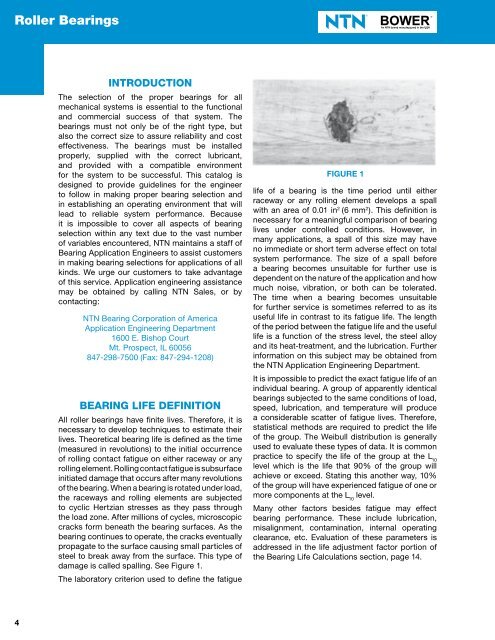You also want an ePaper? Increase the reach of your titles
YUMPU automatically turns print PDFs into web optimized ePapers that Google loves.
<strong>Roller</strong> <strong>Bearings</strong><br />
INTRODUCTION<br />
The selection of the proper bearings for all<br />
mechanical systems is essential to the functional<br />
<strong>and</strong> commercial success of that system. The<br />
bearings must not only be of the right type, but<br />
also the correct size to assure reliability <strong>and</strong> cost<br />
effectiveness. The bearings must be installed<br />
properly, supplied with the correct lubricant,<br />
<strong>and</strong> provided with a compatible environment<br />
for the system to be successful. This catalog is<br />
designed to provide guidelines for the engineer<br />
to follow in making proper bearing selection <strong>and</strong><br />
in establishing an operating environment that will<br />
lead to reliable system performance. Because<br />
it is impossible to cover all aspects of bearing<br />
selection within any text due to the vast number<br />
of variables encountered, <strong>NTN</strong> maintains a staff of<br />
Bearing Application Engineers to assist customers<br />
in making bearing selections for applications of all<br />
kinds. We urge our customers to take advantage<br />
of this service. Application engineering assistance<br />
may be obtained by calling <strong>NTN</strong> Sales, or by<br />
contacting:<br />
<strong>NTN</strong> Bearing Corporation of America<br />
Application Engineering Department<br />
1600 E. Bishop Court<br />
Mt. Prospect, IL 60056<br />
847-298-7500 (Fax: 847-294-1208)<br />
BEARING LIFE DEFINITION<br />
All roller bearings have finite lives. Therefore, it is<br />
necessary to develop techniques to estimate their<br />
lives. Theoretical bearing life is defined as the time<br />
(measured in revolutions) to the initial occurrence<br />
of rolling contact fatigue on either raceway or any<br />
rolling element. Rolling contact fatigue is subsurface<br />
initiated damage that occurs after many revolutions<br />
of the bearing. When a bearing is rotated under load,<br />
the raceways <strong>and</strong> rolling elements are subjected<br />
to cyclic Hertzian stresses as they pass through<br />
the load zone. After millions of cycles, microscopic<br />
cracks form beneath the bearing surfaces. As the<br />
bearing continues to operate, the cracks eventually<br />
propagate to the surface causing small particles of<br />
steel to break away from the surface. This type of<br />
damage is called spalling. See Figure 1.<br />
The laboratory criterion used to define the fatigue<br />
FIGURE 1<br />
life of a bearing is the time period until either<br />
raceway or any rolling element develops a spall<br />
with an area of 0.01 in 2 (6 mm 2 ). This definition is<br />
necessary for a meaningful comparison of bearing<br />
lives under controlled conditions. However, in<br />
many applications, a spall of this size may have<br />
no immediate or short term adverse effect on total<br />
system performance. The size of a spall before<br />
a bearing becomes unsuitable for further use is<br />
dependent on the nature of the application <strong>and</strong> how<br />
much noise, vibration, or both can be tolerated.<br />
The time when a bearing becomes unsuitable<br />
for further service is sometimes referred to as its<br />
useful life in contrast to its fatigue life. The length<br />
of the period between the fatigue life <strong>and</strong> the useful<br />
life is a function of the stress level, the steel alloy<br />
<strong>and</strong> its heat-treatment, <strong>and</strong> the lubrication. Further<br />
information on this subject may be obtained from<br />
the <strong>NTN</strong> Application Engineering Department.<br />
It is impossible to predict the exact fatigue life of an<br />
individual bearing. A group of apparently identical<br />
bearings subjected to the same conditions of load,<br />
speed, lubrication, <strong>and</strong> temperature will produce<br />
a considerable scatter of fatigue lives. Therefore,<br />
statistical methods are required to predict the life<br />
of the group. The Weibull distribution is generally<br />
used to evaluate these types of data. It is common<br />
practice to specify the life of the group at the L 10<br />
level which is the life that 90% of the group will<br />
achieve or exceed. Stating this another way, 10%<br />
of the group will have experienced fatigue of one or<br />
more components at the L 10<br />
level.<br />
Many other factors besides fatigue may effect<br />
bearing performance. These include lubrication,<br />
misalignment, contamination, internal operating<br />
clearance, etc. Evaluation of these parameters is<br />
addressed in the life adjustment factor portion of<br />
the Bearing Life Calculations section, page 14.<br />
4

















